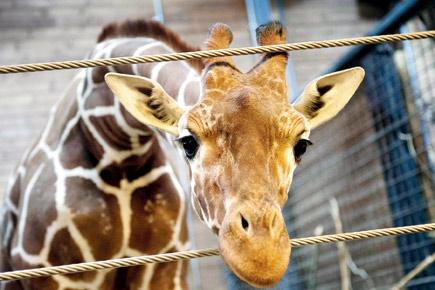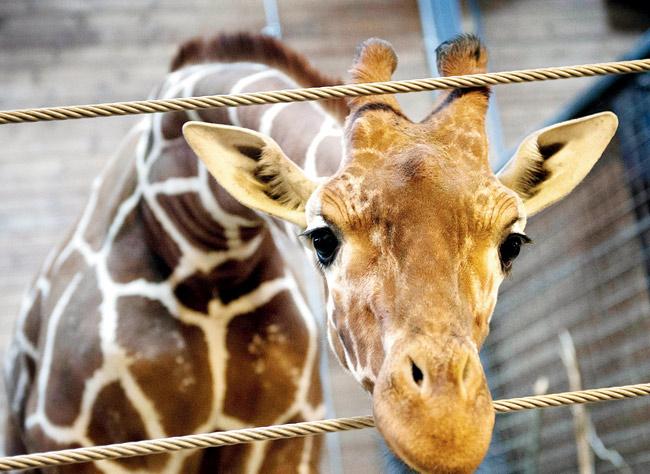Protesters send e-mails saying 'children of all staff should be killed or get cancer'. Anger erupted after the two-year-old giraffe, was shot dead with a bolt gun to prevent inbreeding

Anger erupts: Marius, the two-year-old giraffe, was shot with a bolt gun and his carcass was fed to the other animals in the zoo. Protesters staged an agitation and sent threatening e-mails to the staff at the zoo for euthanising Marius. Pics/AFP
Stockholm: Officials at the Copenhagen Zoo in Denmark say they received death threats after the zoo killed a two-year-old giraffe and fed its remains to lions.

Anger erupts: Marius, the two-year-old giraffe, was shot with a bolt gun and his carcass was fed to the other animals in the zoo. Protesters staged an agitation and sent threatening e-mails to the staff at the zoo for euthanising Marius. Pics/AFP
Zoo spokesman Tobias Stenbaek Bro said yesterday that he and the zoo’s scientific director, Bengt Holst, received several threats over the telephone and in e-mails. They quoted one e-mail as saying: “The children of the staff of Copenhagen Zoo should all be killed or get cancer.”
ADVERTISEMENT

The giraffe, Marius, was killed on Sunday using a bolt pistol, then skinned and fed to lions in front of visitors, including children.
The zoo said it killed Marius to prevent inbreeding, and defended the public feeding as a display of scientific knowledge about animals.
Marius’ plight triggered a wave of online protests and renewed debate about the conditions of zoo animals. Before the giraffe was killed, an online petition to save it had received more than 20,000 signatures.
After the online backlash, the zoo published a Q&A on its website outlining the reasons it would euthanise a healthy giraffe.
The public feeding of Marius’ remains to the lions was popular at Copenhagen Zoo. Stenbaek Bro said it allowed parents to decide whether their children should watch what the zoo regards as an important display of scientific knowledge about animals.
“I’m actually proud because I think we have given children a huge understanding of the anatomy of a giraffe that they wouldn’t have had from watching a giraffe in a photo,” said Stenbaek Bro.
He said the zoo, which now has seven giraffes left, followed the recommendation of the European Association of Zoos and Aquaria to put down Marius by because there already were a lot of giraffes with similar genes in the organisation’s breeding program.
He said his zoo had turned down offers from other ones to take Marius and an offer from a private individual who wanted to buy the giraffe.
“It is no secret that animals are killed when there is no longer space, or if the animals don’t have genes that are interesting enough,” it said in a statement. “The only way to stop this is to not visit zoos.”
Cruel treatment
Elisa Allen, spokeswoman for People for the Ethical Treatment of Animals in the UK, said Marius’ case should serve as a wake-up call for anyone who ‘still harbours the illusion that zoos serve any purpose beyond incarcerating intelligent animals for profit’.
She said in a statement, “Giraffes rarely die of old age in captivity, and had Marius not been euthanised today, he would have lived out his short life as a living exhibit, stranded in a cold climate, thousands of miles away from his true home.”
20,000
Number of people who signed a petition asking to save Marius from death
80,000
Approximate number of giraffes left in the world
$682,000
Amount offered to buy Marius from the zoo
 Subscribe today by clicking the link and stay updated with the latest news!" Click here!
Subscribe today by clicking the link and stay updated with the latest news!" Click here!







